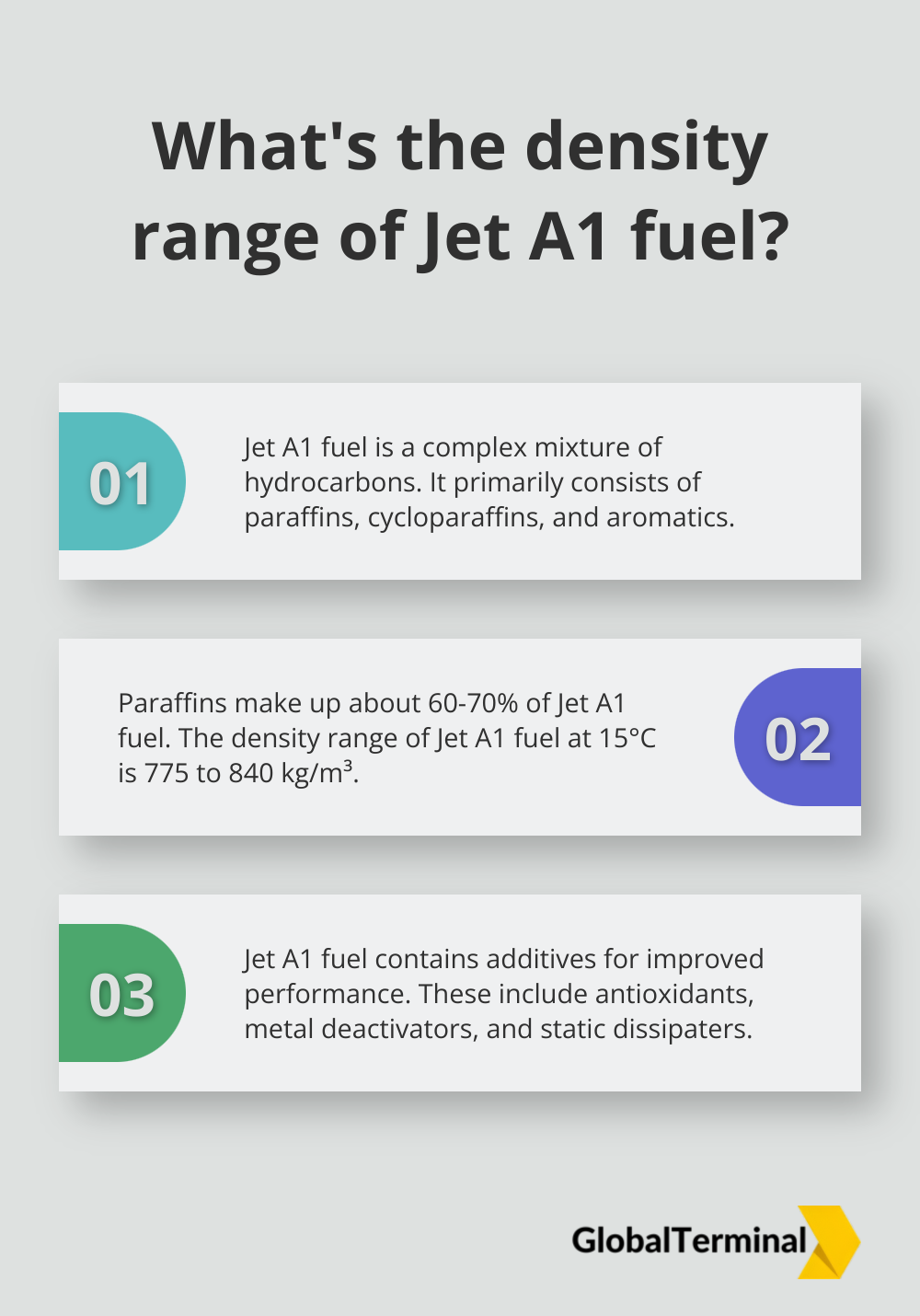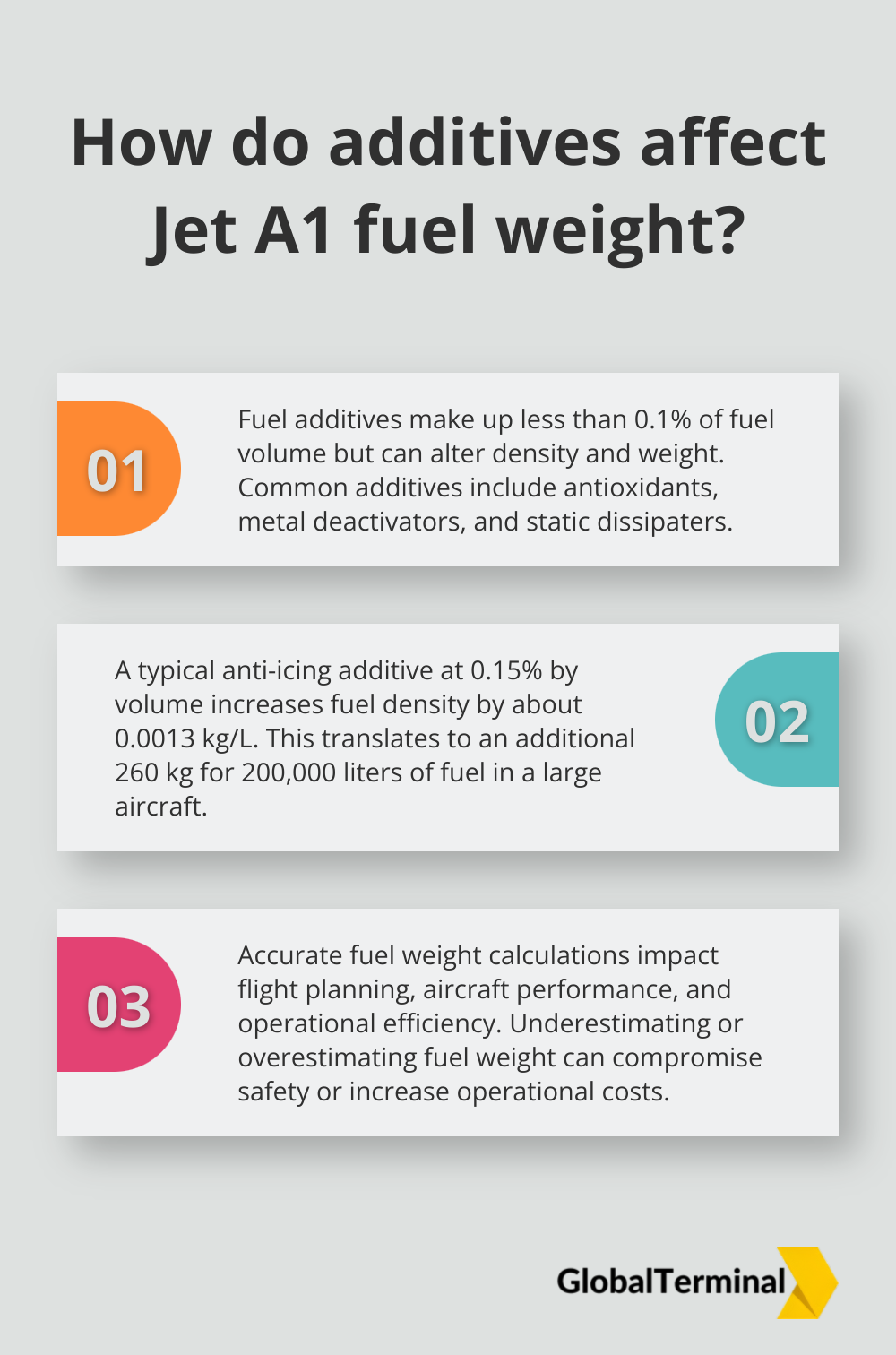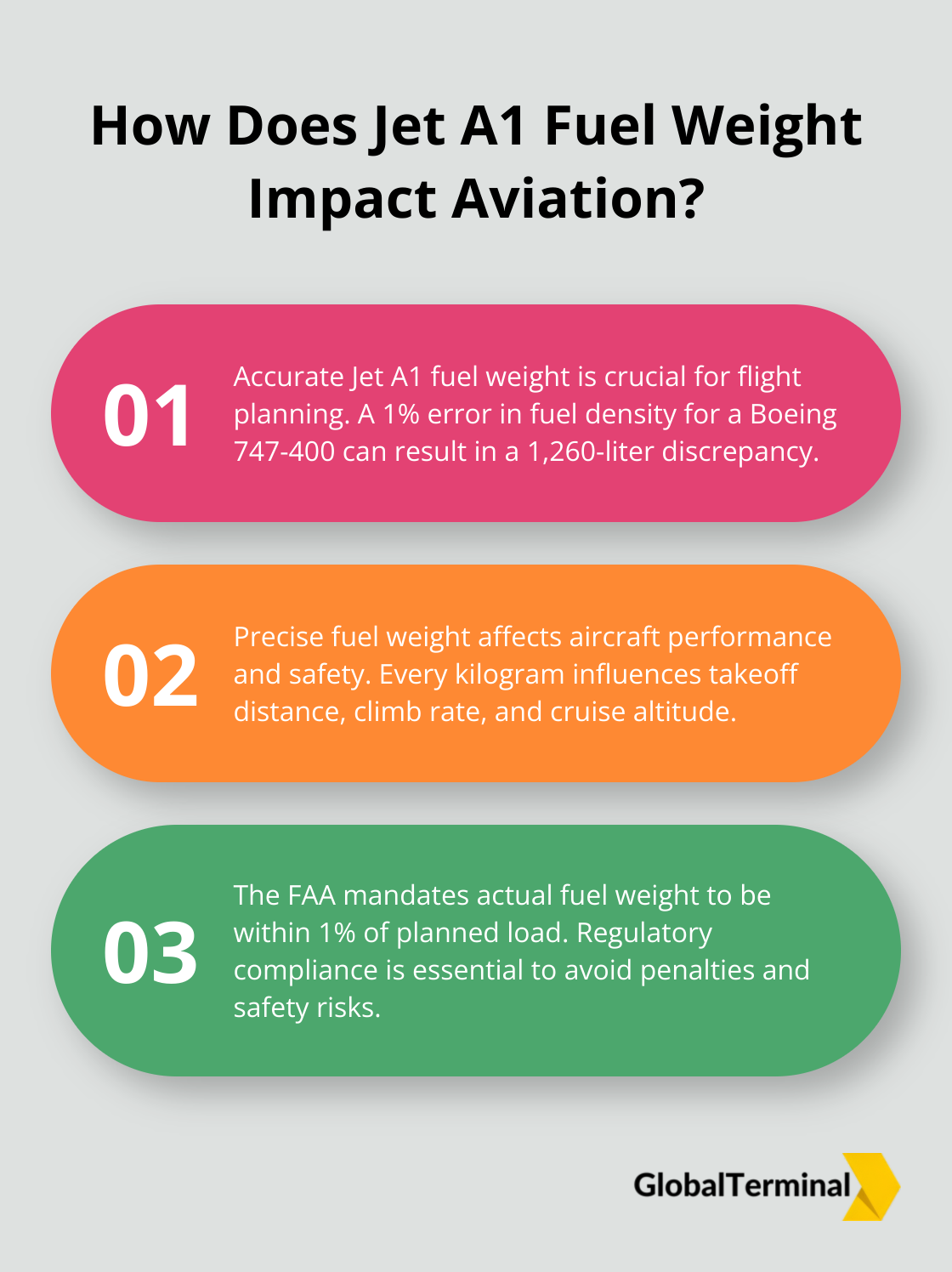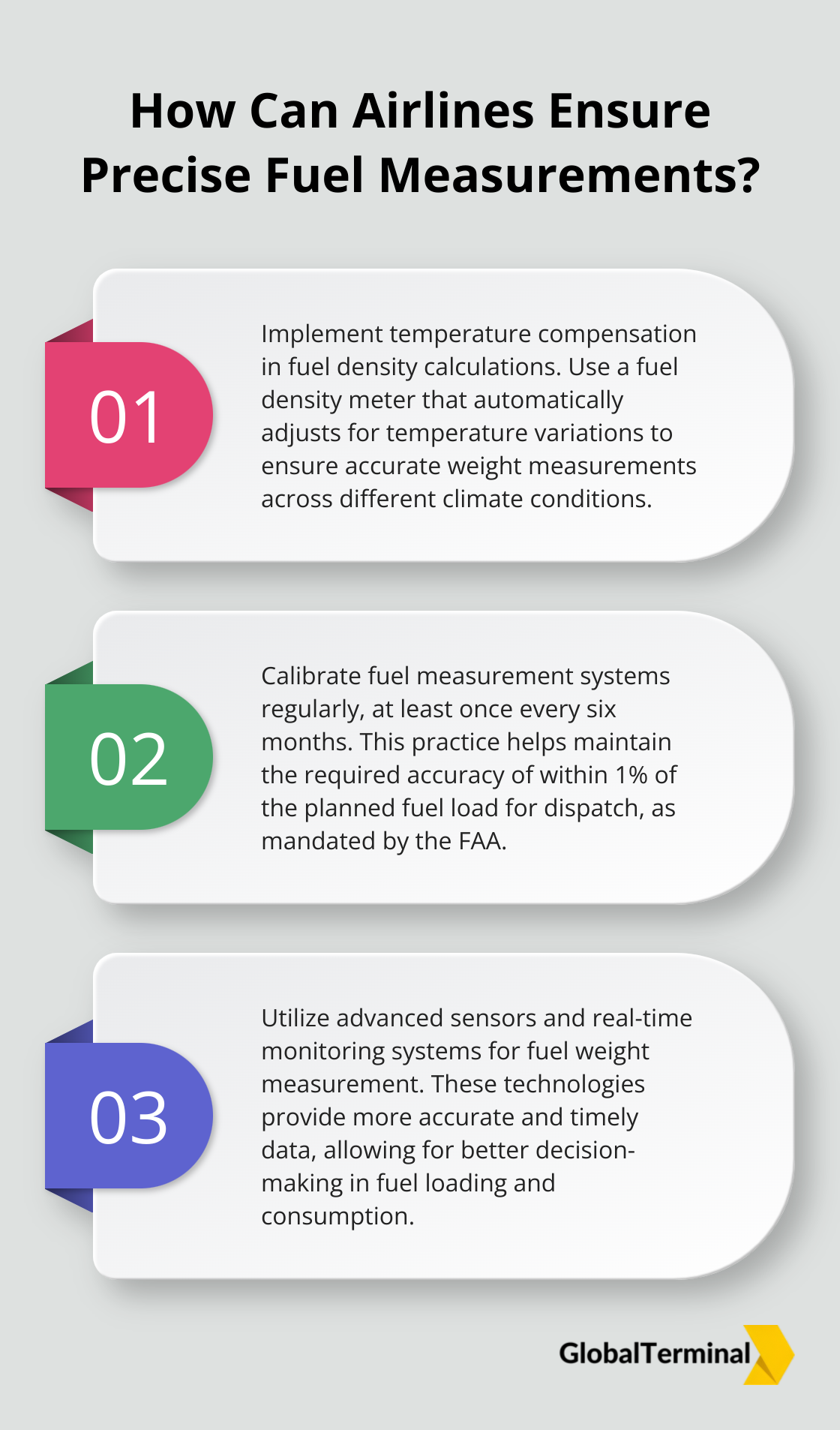
Understanding Jet A1 Fuel Weight: Important Factors
At GLOBAL TERMINAL NETHERLANDS B.V, we understand the critical role Jet A1 fuel weight plays in aviation operations. This essential factor impacts everything from flight planning to aircraft performance and safety.
In this post, we’ll explore the key aspects that influence Jet A1 fuel weight and why precise measurement is vital. We’ll also delve into future trends that could shape fuel weight optimization in the aviation industry.
What’s in Jet A1 Fuel?
Jet A1 fuel is a complex mixture of hydrocarbons, formulated to meet the demanding requirements of modern aircraft engines. Understanding its composition is essential for efficient aviation operations.
The Hydrocarbon Blend
Jet A1 primarily consists of a blend of different hydrocarbons, including paraffins, cycloparaffins, and aromatics. The exact proportions can vary, but typically, paraffins make up about 60-70% of the fuel. These straight-chain hydrocarbons provide excellent combustion properties and help maintain the fuel’s stability during storage.
Density and Weight Considerations
The density of Jet A1 fuel is a critical factor in aviation operations. At 15°C, Jet A1 has a density range of 775 to 840 kg/m³. This variation can significantly impact fuel weight calculations. For instance, a difference in density can result in a weight discrepancy for a typical wide-body aircraft fuel load.
Energy Content and Efficiency
Jet A1 fuel boasts a high energy content. This high energy density is vital for long-haul flights where fuel efficiency is paramount. Airlines and operators can optimize their fuel usage by understanding this energy content in relation to the fuel’s weight.
Additives and Performance Enhancers
To improve performance and stability, Jet A1 fuel often contains small amounts of additives. These can include:
- Antioxidants (to prevent gum formation)
- Metal deactivators (to reduce corrosion)
- Static dissipaters (to prevent static electricity buildup)

These additives play a significant role in maintaining fuel quality and safety.
Quality Control and Standards
Strict quality control measures ensure that Jet A1 fuel meets international standards (such as ASTM D1655 and DEF STAN 91-91). These standards specify the acceptable ranges for various properties, including flash point, freezing point, and sulfur content.
The complex nature of Jet A1 fuel underscores the importance of precise handling and storage. As we move forward, we’ll explore how various factors can affect the weight of this essential aviation fuel.
What Impacts Jet A1 Fuel Weight?
Temperature’s Influence on Fuel Density
Temperature significantly affects Jet A1 fuel weight. If a design change or modification results in an adverse change to the fuel efficiency metric value, it may be less than the proposed threshold.
Altitude and Pressure Effects
Altitude and atmospheric pressure also impact Jet A1 fuel weight. A standard pressure lapse rate is one in which pressure decreases at a rate of approximately 1 “Hg per 1,000 feet of altitude gain to 10,000 feet.
The Impact of Fuel Additives
Fuel additives, while essential for enhancing performance and safety, can also affect Jet A1 fuel weight. These additives (which typically make up less than 0.1% of the fuel volume) can slightly alter the overall density and weight of the fuel.

Common additives include antioxidants, metal deactivators, and static dissipaters. While their impact on weight is minimal, it’s important for precise calculations, especially for large aircraft or long-haul flights where every pound matters.
The addition of a typical anti-icing additive at 0.15% by volume can increase the fuel density by about 0.0013 kg/L. For a large aircraft carrying 200,000 liters of fuel, this translates to an additional 260 kg of weight – a factor that needs consideration in weight and balance calculations.
Real-World Implications
These factors have significant real-world implications for aviation professionals. Accurate fuel weight calculations directly impact flight planning, aircraft performance, and operational efficiency. Airlines and operators must account for these variables to ensure safe and cost-effective operations.
For example, underestimating fuel weight due to temperature variations could lead to incorrect takeoff weight calculations, potentially compromising safety. Conversely, overestimating fuel weight might result in unnecessary fuel carriage, increasing operational costs.
Understanding these nuances in fuel weight management is key to maintaining operational excellence in the ever-evolving aviation industry. As we move forward, we’ll explore why precise measurement of Jet A1 fuel weight is so important for various aspects of flight operations.
Why Precise Jet A1 Fuel Weight Matters
Critical Role in Flight Planning
Accurate measurement of Jet A1 fuel weight forms the foundation of efficient and safe aviation operations. Airlines and operators use this data to determine the optimal amount of fuel for each flight. During flight, fuel burn is normally the only weight change that takes place. As fuel is used, an aircraft becomes lighter and performance is improved.

Consider a Boeing 747-400 flying from New York to London. It carries approximately 126,000 liters of fuel. A 1% error in fuel density measurement could result in a discrepancy of 1,260 liters (about 1,000 kg). This difference significantly affects range calculations and payload decisions.
Impact on Aircraft Performance
Precise fuel weight measurement directly influences aircraft performance. Every kilogram of weight affects takeoff distance, climb rate, and cruise altitude. Accurate fuel level measurement ensures pilots can manage fuel effectively, avoid fuel exhaustion, and plan their flights with precision.
Airlines utilize sophisticated flight planning software that relies on accurate fuel weight data to optimize routes and altitudes. These systems can save millions of dollars annually in fuel costs, but their effectiveness depends on precise input data.
Safety and Regulatory Compliance
Safety stands as the top priority in aviation, and accurate fuel weight measurement plays a vital role. Incorrect weight calculations can lead to improper weight and balance, which potentially compromises aircraft stability and control.
Regulatory bodies like the Federal Aviation Administration (FAA) and the European Union Aviation Safety Agency (EASA) mandate strict adherence to weight limits. Exceeding these limits due to inaccurate fuel weight measurement can result in severe penalties and safety risks.
The FAA requires that the actual weight of fuel on board falls within 1% of the planned fuel load for dispatch. This narrow margin underscores the importance of precise measurement.
Technological Advancements
The aviation industry continues to innovate in fuel weight measurement technologies. Advanced sensors and real-time monitoring systems (such as those used by GLOBAL TERMINAL NETHERLANDS B.V.) provide more accurate and timely data. These technologies help airlines and operators make informed decisions about fuel loading and consumption.
Economic Implications
Precise fuel weight measurement has significant economic implications for airlines and operators. Accurate data allows for optimized fuel loads, which can lead to substantial cost savings over time. Even small improvements in fuel efficiency (achieved through precise weight management) can translate to millions of dollars in savings for large airlines.
Final Thoughts
Understanding Jet A1 fuel weight impacts every aspect of aviation operations. Temperature, altitude, and additives all affect the precise weight of this essential resource. Accurate measurement of Jet A1 fuel weight influences flight planning, aircraft performance, and operational costs.

We expect future advancements in fuel weight optimization technologies to improve precision in fuel management. These innovations will enhance safety and contribute to reducing the industry’s environmental footprint. The importance of reliable fuel storage and logistics solutions remains paramount in supporting accurate Jet A1 fuel weight management.
GLOBAL TERMINAL NETHERLANDS B.V provides state-of-the-art facilities and services for the aviation industry. Our strategic locations, advanced monitoring systems, and experienced team support our partners’ core operations. The aviation industry will continue to evolve, as will our understanding and management of this critical factor.





Leave a Reply